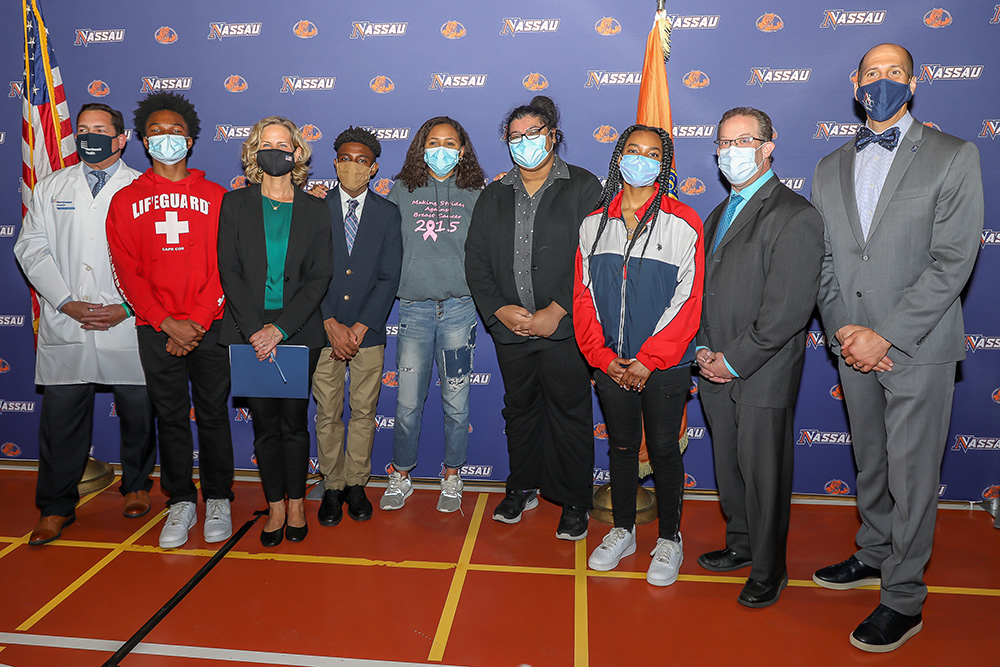Gender gap in vaccination narrower among youth than adults, early numbers show
Asher Lehrer-Small | June 17, 2021
Your donation will help us produce journalism like this. Please give today.

Hamilton Bermudez, 14, receives his COVID-19 vaccine at Abraham Lincoln High School in Los Angeles, California on May 13. (Frederic J. Brown/Getty Images)
As young people continue to line up for coronavirus shots, the gender breakdown appears, well, surprisingly even.
Compared to a persistent gap between adult men and women in vaccination rates, with women rolling up their sleeves considerably more than men nationwide, early data indicate that the split has been far less pronounced among youth.
In Rhode Island, as of early June, young people had seen only a 4 percentage point difference between males and females in COVID-19 immunization, according to numbers provided by the Rhode Island Department of Health, compared to a 7 percentage point gap among the state’s population at large. On the same timescale in Vermont, the gender split was even narrower, at 2 percentage points among vaccinated youth, according to Vermont Department of Health statistics, compared to 6 percentage points among all vaccinated individuals.
Nicolette Carrion, a first-year at Georgetown University from Nassau County, New York, understands the numbers as being due to “generational difference.”
Young people today are “brought up in a different society,” Carrion told The 74. Not only are kids eager to socialize and connect with peers, but living through a pandemic has helped raise their social consciousness from an early age.
“From what I’ve seen, the care for other people, I think it’s a whole different level,” she said.
Among youth, the gender gap in immunization appears to shrink further when students have increased access to vaccinations.
In Carrion’s home county on Long Island, schools launched a youth vaccination campaign complete with student ambassadors to answer peers’ questions about the shots. Amid their immunization push, rates of inoculation stood virtually even, with 50.1 percent of shots going to young women and 49.9 percent going to young men, according to data provided by the county in late May. East Hartford, Connecticut, which hosted a senior “skip day” for vaccinations in late April, immunized 130 female students and 134 males, the district said.
Carrion, who worked as a vaccine ambassador, said that the even immunization rates across gender for students in Nassau County reflected the conversations she had with her peers.
“I never really saw a difference with how my male peers and female peers spoke about the vaccines,” said Carrion. “They wanted to live out their lives as young people and that’s really what it was all about.”

The Nassau County youth vaccine ambassadors, accompanied by, left to right, Dr. Daniel Fagan of Northwell Health, Nassau County Executive Laura Curran, Nassau County Commissioner of Health Lawrence Eisenstein and Dr. Jermaine Williams, President of Nassau Community College. Nicolette Carrion stands center in grey hoodie. (Office of the Nassau County Executive)
Among adults, on the other hand, longstanding gender gaps have persisted nationwide. In April, the gap measured about 10 percentage points, which some observers initially wrote off as the result of women holding occupations that received early vaccine priority at higher rates than men. But even as access to shots widened, the disparity has remained persistent, with the Centers for Disease Control and Prevention reporting this week that 53 percent of all vaccine-eligible women have received at least one dose, while the same is true for only 47 percent of vaccine-eligible men.
Reports from early in the pandemic found that men were less likely to wear masks and follow virus-related safety protocols, due to ideas that doing so would be a “sign of weakness.”
For Rohith Raman, however, a graduating high school senior in Houston, Texas, the choice was simple. He lives with his grandmother, and his sister has severe asthma, so Raman got a shot as soon as he was eligible.
“It was a pretty cut-and-dry decision,” the Houston senior told The 74. Now he can visit with friends without the risk of bringing the virus home. “A little bit of stress has been relieved.”
Most of the young people in Raman’s social circle have also received their vaccinations. He credits social media with applying a positive peer effect on students, encouraging them to get immunized.
“There is a huge ripple effect when you see your friends getting [the shot],” said Raman.
In mid-May, the Food and Drug Administration authorized youth aged 12 to 15 for shots based on their existing emergency use approval. And though children are still considered much less likely to develop severe symptoms or die from COVID-19, a third of kids who were hospitalized for the disease in early 2021 were admitted to intensive care, and 5 percent required ventilators, according to a CDC study. Boys account for 56 percent of all COVID deaths among youth under 18 while girls make up 44 percent, CDC numbers show.
With more adults now immunized than youth, and with kids under 12 likely not eligible for doses until the fall, young people represent an increasing share of total cases, and health experts are emphasizing the importance of immunizing youth.
Carrion, who after a year of remote classes was able to step onto her college campus for the first time in early June thanks to her vaccination, also emphasized the social upside to immunization for people her age, in addition to the public health reasons. It was prom season in late May and now it’s graduation season, she points out, and students don’t want to be stuck on the sidelines.
“We see the benefits in real time,” she said.
This article was published in partnership with The 74. Sign up for The 74’s newsletter here.